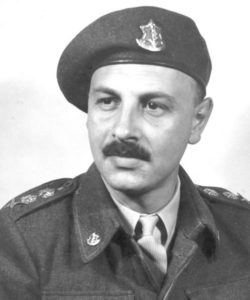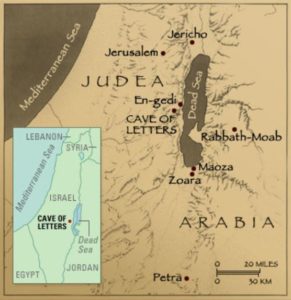The War Hero Archaeologist Who Made a Revolutionary Discovery
Babatha bat Shimon (c. 104-132 CE) was born in the town of Mahoza by the Dead Sea to a wealthy Jewish family originally from Ein Gedi. It was in this area that Israeli archaeologist Yigael Yadin discovered a leather pouch with her belongings in 1960. The documents inside included her legal, financial, and marriage contracts, presenting an eye-opening picture of the life of an upper-class Jewish woman two millennia ago. An only child, Babatha inherited all of her father’s date palm orchards when he passed away. She married her first husband, a man named Yeshu, while still a teenager. He died several years later, after which she married another date farmer named Yehuda. One of the discovered documents shows that Babatha lent her husband a sizeable loan (interest-free, of course). When he also passed away, Babatha seized all of his property as collateral. The documents reveal a number of legal battles that Babatha had to overcome, as well as her impressive financial and business acumen. She spoke several languages and was well-educated. During the Bar Kochva Revolt, Babatha fled from the Romans and hid in a cave, together with one of Bar Kochva’s generals, named Yonatan. It is believed she was killed in the war shortly after. Archaeologist Richard Freund has said that Babatha “revolutionized the way that we think about Jewish women in antiquity.”
 Yigael Sukenik (1917-1984) was born in Israel to Polish-Jewish parents. He joined the Haganah at 15, leaving several years later after a dispute with Yitzhak Sadeh. He decided to follow in his father’s footsteps and become an archaeologist. While studying at the Hebrew University he changed his last name to “Yadin”. When Israel’s Independence War broke out, Yadin returned to the newly-formed IDF and became the head of its operations. The following year, he became Chief of Staff. One of his first duties was going to Switzerland to study their army-reserve organization. He then created a similar reverse system in Israel. After resigning from the IDF to protest defence budget cuts, Yadin returned to academia. His doctoral thesis on a translation of the Dead Sea Scrolls won an Israel Prize. He travelled around the world to find and purchase lost and stolen Dead Sea Scrolls to return them to Israel. Meanwhile, Yadin excavated some of the most important archaeological sites in Israel, including Masada, Hazor, and Ein Gedi. During the Six-Day War, he returned to the military to advise the prime minister, and years later was part of the Agranat Commission that investigated the failure of the Yom Kippur War. As a result of this, he formed a new political party, Dash, which sought to fight corruption and restore confidence in Israel’s government. The party won a whopping 15 seats in its first election, and soon joined the new Likud coalition under Menachem Begin. Yadin became deputy prime minister, and played a critical role in the Camp David Accords. He wrote a number of bestselling books, taught at the Hebrew University for over 30 years, and was a renowned expert on the Qumran Caves, the Dead Sea Scrolls, and the Bar Kochva Revolt.
Yigael Sukenik (1917-1984) was born in Israel to Polish-Jewish parents. He joined the Haganah at 15, leaving several years later after a dispute with Yitzhak Sadeh. He decided to follow in his father’s footsteps and become an archaeologist. While studying at the Hebrew University he changed his last name to “Yadin”. When Israel’s Independence War broke out, Yadin returned to the newly-formed IDF and became the head of its operations. The following year, he became Chief of Staff. One of his first duties was going to Switzerland to study their army-reserve organization. He then created a similar reverse system in Israel. After resigning from the IDF to protest defence budget cuts, Yadin returned to academia. His doctoral thesis on a translation of the Dead Sea Scrolls won an Israel Prize. He travelled around the world to find and purchase lost and stolen Dead Sea Scrolls to return them to Israel. Meanwhile, Yadin excavated some of the most important archaeological sites in Israel, including Masada, Hazor, and Ein Gedi. During the Six-Day War, he returned to the military to advise the prime minister, and years later was part of the Agranat Commission that investigated the failure of the Yom Kippur War. As a result of this, he formed a new political party, Dash, which sought to fight corruption and restore confidence in Israel’s government. The party won a whopping 15 seats in its first election, and soon joined the new Likud coalition under Menachem Begin. Yadin became deputy prime minister, and played a critical role in the Camp David Accords. He wrote a number of bestselling books, taught at the Hebrew University for over 30 years, and was a renowned expert on the Qumran Caves, the Dead Sea Scrolls, and the Bar Kochva Revolt.
Words of the Week
Also I have seen under the sun, that in the place of law there is evil, and in the place of justice there is evil.
– King Solomon (Ecclesiastes 3:16)


 Eilat Mazar (1956-2021) was born in Israel to a family of archaeologists, and grew up playing and learning on excavation sites. Her grandfather, Benjamin Mazar, was the State of Israel’s first official archaeologist, and was the president of the Hebrew University. Eilat studied archaeology at the same university, and began her field work in 1981. She made a big splash right away by discovering the Royal Quarter of the ancient City of David in Jerusalem, including what is thought to be the royal palace of King David himself. She went on to uncover some of the biggest finds of the last century, including parts of the walls built by King Solomon, the seal of King Hezekiah, and the seal of the Prophet Isaiah. Mazar was driven by her belief that the Tanakh records actual historical events (whereas many of her secular colleagues often viewed the Tanakh as mythology). She would say that “I work with the Bible in one hand and the tools of excavation in the other.” Over the decades, her work played a major role in helping to prove the authenticity of the Bible. Mazar discovered countless treasures from the First and Second Temples in Jerusalem, and was a vocal activist trying to stop Palestinian and Jordanian authorities from
Eilat Mazar (1956-2021) was born in Israel to a family of archaeologists, and grew up playing and learning on excavation sites. Her grandfather, Benjamin Mazar, was the State of Israel’s first official archaeologist, and was the president of the Hebrew University. Eilat studied archaeology at the same university, and began her field work in 1981. She made a big splash right away by discovering the Royal Quarter of the ancient City of David in Jerusalem, including what is thought to be the royal palace of King David himself. She went on to uncover some of the biggest finds of the last century, including parts of the walls built by King Solomon, the seal of King Hezekiah, and the seal of the Prophet Isaiah. Mazar was driven by her belief that the Tanakh records actual historical events (whereas many of her secular colleagues often viewed the Tanakh as mythology). She would say that “I work with the Bible in one hand and the tools of excavation in the other.” Over the decades, her work played a major role in helping to prove the authenticity of the Bible. Mazar discovered countless treasures from the First and Second Temples in Jerusalem, and was a vocal activist trying to stop Palestinian and Jordanian authorities from 